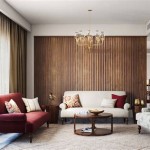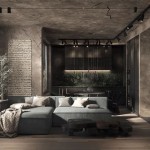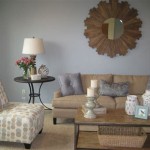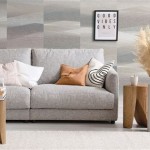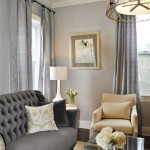Living Room Without a Couch: Rethinking Seating and Space
The traditional living room setup often revolves around a central piece: the sofa. It is assumed to be the primary seating option, influencing the layout and dictating the overall ambiance. However, the concept of a living room devoid of a couch is gaining traction, driven by the desire for flexibility, unique aesthetics, and optimized use of space. The absence of a couch necessitates a reimagining of seating arrangements and functionality, leading to creative solutions that prioritize individual needs and lifestyle.
Moving beyond the conventional couch allows for a more personalized and adaptable living space. It challenges the assumption that a sofa is essential for comfort or sociability, opening doors to innovative seating options and spatial organization. The decision to forgo a couch can stem from various motivations, including limited space, a preference for minimalist design, or a desire to cultivate a more interactive and dynamic environment.
Maximizing Space with Alternative Seating
One of the most compelling reasons to consider a living room without a couch is the opportunity to maximize available space. Couches, particularly larger sectionals, can dominate a room, making it feel cramped and restricting movement. Removing this bulky furniture item immediately creates a sense of openness, which is especially beneficial in smaller homes or apartments. The freed-up space can then be utilized for other activities or furniture pieces, enhancing the room's functionality without adding clutter.
Instead of a couch, alternative seating arrangements can be employed to accommodate various needs. Individual armchairs offer flexibility and can be easily rearranged to suit different situations, such as intimate conversations or larger gatherings. Smaller ottomans and poufs provide additional seating options that can be easily stored away when not in use. These versatile pieces allow for dynamic space management, adapting to the changing demands of daily life.
Floor cushions and beanbag chairs offer a more casual and relaxed seating experience. These options are particularly suitable for informal living rooms or spaces designed for relaxation and entertainment. Floor cushions can be arranged around a low coffee table, creating a comfortable and inviting space for socializing or enjoying leisure activities. Beanbag chairs provide supportive seating that conforms to the body, making them ideal for reading, watching movies, or simply unwinding after a long day.
Built-in seating is another effective solution for maximizing space and creating a cohesive design. Window seats, banquettes, or custom-built benches offer comfortable seating without taking up valuable floor space. These built-in options can be tailored to the specific dimensions of the room, providing a seamless and integrated look. They can also incorporate storage compartments, further enhancing their functionality and contributing to a clutter-free environment.
Embracing Versatility and Functionality
The absence of a couch encourages a more versatile and functional approach to living room design. Without the constraint of a large, fixed piece of furniture, the room can be easily adapted to serve multiple purposes. The space can be transformed from a relaxation zone to a home office, a yoga studio, or a play area for children, depending on the needs of the occupants.
Multipurpose furniture pieces are essential in a couch-less living room. Coffee tables with lift-top mechanisms can be converted into dining tables or workstations. Storage ottomans provide seating and concealed storage space for blankets, pillows, or other household items. Folding chairs can be easily stored away when not needed, providing extra seating for guests without cluttering the room.
The layout of the living room should prioritize flexibility and ease of movement. Avoid overcrowding the space with unnecessary furniture or accessories. Opt for lightweight and easily movable pieces that can be rearranged as needed. This allows for quick adaptation to different activities and social situations. Consider incorporating modular furniture systems that can be configured in various ways to suit the changing needs of the occupants.
Area rugs can define different zones within the living room, creating a sense of order and visual separation. A large rug can anchor the seating arrangement, while smaller rugs can delineate separate areas for reading, working, or playing. The use of rugs can also add warmth and texture to the space, enhancing its overall comfort and aesthetic appeal.
Creating a Unique and Personalized Aesthetic
A living room without a couch offers a unique opportunity to express personal style and create a distinctive aesthetic. The absence of a conventional sofa challenges the status quo, allowing for experimentation with different seating arrangements, color palettes, and decorative elements. This departure from tradition can result in a living space that is both visually appealing and reflective of the occupants' individual tastes.
Armchairs can be chosen in a variety of styles, from mid-century modern to contemporary, to complement the overall design theme. Mix and match different armchair styles to create an eclectic and visually interesting seating arrangement. Consider incorporating accent chairs with bold patterns or vibrant colors to add personality and visual interest to the space.
Textiles play a crucial role in creating a comfortable and inviting atmosphere. Use a variety of textures, such as velvet, linen, and wool, to add depth and dimension to the seating area. Throw pillows and blankets can be used to add pops of color and pattern, enhancing the overall aesthetic appeal. Consider incorporating natural materials, such as wood, stone, and plants, to create a sense of warmth and connection to nature.
Artwork and accessories can further personalize the living room and reflect the occupants' interests and passions. Display favorite paintings, photographs, or sculptures to create a gallery-like atmosphere. Incorporate personal mementos, such as travel souvenirs or family heirlooms, to add sentimental value to the space. The careful selection and arrangement of artwork and accessories can transform a living room into a unique and personalized reflection of the occupants' identity.
Lighting is essential for creating the desired ambiance in the living room. Use a combination of ambient, task, and accent lighting to achieve optimal illumination. Overhead lighting can provide general illumination, while table lamps and floor lamps can create more focused light for reading or working. Accent lighting can be used to highlight artwork or architectural features, adding depth and visual interest to the space. The strategic use of lighting can dramatically enhance the overall atmosphere and mood of the living room.
Ultimately, designing a living room without a couch is about embracing creativity and prioritizing individual needs and preferences. It is an opportunity to break free from conventional design norms and create a space that is both functional and aesthetically pleasing. By carefully considering alternative seating options, maximizing space, and personalizing the aesthetic, it is possible to create a living room that is both unique and inviting, without the need for a traditional sofa.

9 Seating Alternatives For A No Sofa Living Room Houzz

9 Seating Alternatives For A No Sofa Living Room Houzz

How To Design A Living Room Without Sofa

How To Design A Living Room Without Sofa

When Is It A Good Idea To Ditch The Sofa In An Awkward Living Room Michael Helwig Interiors

10 Unique Ways To Setup Living Room Without Sofa

How To Create A Living Room Without Sofa 2024 Gui Weiken Interior Design

Living Room Without Sofa

9 Seating Alternatives For A No Sofa Living Room Houzz

How To Design A Living Room Without Sofa

